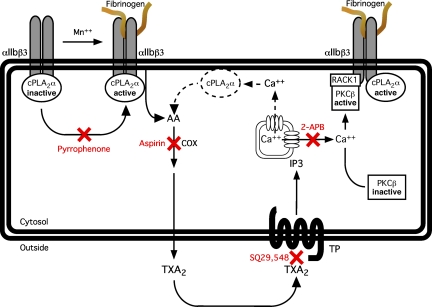Figure 6.
Model depicting the relationship between cPLA2α and αIIbβ3. MnCl2-induced fibrinogen binding to platelets induces the activation of αIIbβ3-associated cPLA2α, leading to the release of AA from membrane phospholipids and cyclooxygenase-mediated thromboxane A2 production. Activation of the TxA2/prostaglandin H2 receptor by thromboxane A2 leads to the production of inositol-1,4,5-triphosphate and IP3 receptor-mediated release of free calcium from the dense tubular system. The elevation in cytosolic Ca2+ concentration, in turn, promotes the activation of PKC-β and its subsequent recruitment to αIIbβ3 via RACK1. Another consequence of G-protein-mediated Ca2+ release downstream of TxA2, thrombin, or ADP receptors is the activation of additional pools of cPLA2α (dotted lines). COX indicates cyclooxygenase; TXA2, thromboxane A2, TP, thromboxane A2/prostaglandin H2 receptor, IP3, inositol-1,4,5-triphosphate.

